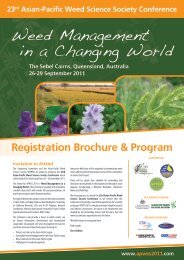PARAQUAT
PARAQUAT
PARAQUAT
You also want an ePaper? Increase the reach of your titles
YUMPU automatically turns print PDFs into web optimized ePapers that Google loves.
elated paraquat poisonings are believed to<br />
be signifi cantly underreported and suicides<br />
over-represented in surveillance data (Murray<br />
et al 2002), including misclassifi cation of<br />
occupational cases (Wesseling et al 1997). Nonoccupational<br />
poisonings – equally important –<br />
will be addressed in the following sections.<br />
Most occupational poisonings occur in<br />
developing countries where deficient working<br />
conditions, improper maintenance of equipment,<br />
climatic conditions, illiteracy, and poverty make<br />
controlled and ‘safe’ use of paraquat extremely<br />
difficult.<br />
Occupational exposure<br />
Paraquat can enter the body when swallowing,<br />
breathing, or by contact with the skin or eyes. The<br />
main route of exposure in agriculture is through<br />
the skin. Exposure occurs primarily through<br />
splashing during preparation of the spray and<br />
its transport, or when fi lling a knapsack sprayer;<br />
deposition of spray mist; leaking of a knapsack<br />
sprayer; adjusting spray equipment; and walking<br />
through sprayed vegetation. Hence the most<br />
exposed areas are hands, wrists, legs, back,<br />
and genitals (Wesseling et al 2001a).<br />
Paraquat is a contact herbicide; plant growth is<br />
rapid in humid, hot climates; and spraying occurs<br />
with high frequency (every 6 to 8 weeks) in<br />
many tropical countries: these factors can cause<br />
frequent occupational exposure (Wesseling et al<br />
2001a).<br />
Dermal<br />
Although dermal absorption is low through intact<br />
skin, it is considerably higher through damaged<br />
skin including skin that may be initially irritated<br />
by the paraquat, and a number of deaths have<br />
been reported from such exposure, including to<br />
the diluted spray solution.<br />
Studies carried out in collaboration with Syngenta<br />
(and its forebears) concluded that paraquat is<br />
unlikely to cause serious occupational health<br />
problems, despite several of the studies<br />
showing 40-50% of workers experience topical<br />
effects. Other researchers have concluded<br />
that paraquat sprayers are continuously at<br />
risk of high exposures that can lead to severe<br />
injury and poisoning (Wesseling et al 2001a).<br />
One recent study of paraquat use in Malaysia<br />
showed that manual knapsacks resulted in high<br />
levels of dermal exposure (Mohd Rafee et al<br />
2010). Earlier studies had found lower levels,<br />
but nevertheless four out of six studies found<br />
paraquat in urine of users at the end of the<br />
working day (Wesseling et al 2001a). Sprayers<br />
using knapsacks are more likely to be exposed<br />
to high levels of paraquat; and heavy prolonged<br />
dermal exposure as from a leaking knapsack<br />
sprayer can result in severe poisoning or death<br />
(US EPA 1997). One farmer died after spraying<br />
correctly diluted paraquat for 3.5 hours with a<br />
leaking knapsack (Wesseling et al 2001a).<br />
A study of exposure to paraquat from knapsack<br />
spraying in Costa Rican banana plantations<br />
found that the sprayers were “continuously at<br />
risk of high exposures that could lead to severe<br />
intoxication”. Health problems recorded included<br />
blistering and burns on hands, thighs, back,<br />
testicles and legs; redness and burning of eyes<br />
from splashes; and nosebleeds (van Wendel de<br />
Joode et al 1996).<br />
Motorised knapsacks can also result in unsafe<br />
exposure. A study of exposure levels in pesticide<br />
sprayers in Egypt’s cotton fi elds showed that<br />
exposure was occurring on 3.6% of the head,<br />
23.7% of the body, and 29.1% of the legs. This<br />
was considerably more than for manual nonleaking<br />
knapsacks (head 0.76%, body 4.8%,<br />
legs 5.8%) (Elhalwagy et al 2010).<br />
The US EPA (1997) concluded, after fi eld studies<br />
on workers, that exposure was unacceptable for<br />
backpack applicators who mixed, loaded and<br />
applied paraquat, and for those who used low<br />
pressure sprayers, even when they wore long<br />
pants, long-sleeved shirt, socks, shoes, and<br />
chemical-resistant gloves.<br />
The EU reported estimates from exposure<br />
models showing that the exposure of knapsack<br />
sprayers to paraquat may exceed the short term<br />
AOEL by 60 times when protective equipment<br />
is worn and 100 times when it is not worn (EC<br />
2002).<br />
Wearing of protective clothing and equipment<br />
can reduce exposure, but it is frequently not<br />
worn in developing countries for a variety<br />
of reasons including its expense, lack of<br />
availability, and unsuitability for hot humid<br />
climates. Studies have shown that, even when<br />
it is worn, exposure still occurred in areas with<br />
21




